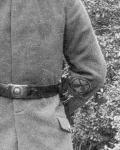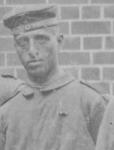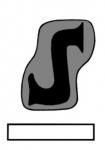
Thomas W
For Deletion-
Posts
788 -
Joined
-
Last visited
-
Days Won
3
Content Type
Profiles
Forums
Blogs
Gallery
Events
Store
Everything posted by Thomas W
-
Saxon infantryman wearing the white flamethrower death's head in the position adopted by the flamethrower platoon of Assault Battalion No. 5 (Rohr). This guy would have to have been a pioneer first, and then transferred into the infantry. I have five different photos that show this precise pattern of death's head, so it must have been official. The Rohr "W" badge appears in several different configurations, including metal and cloth. That may indicate that there was no official pattern for it.
-
Gruss isn't infallible; he says in that quote that the flamethrower regiment wore a "silver" death's head. The death's head was silver only for officers. The men wore a gray death's head. There's also a white death's head of a different pattern. But to say that all flamethrower pioneers wore a silver death's head is inaccurate.
-
Actually, the Gruss quote says nothing about the official or unofficial status of either badge. It simply says that both units wore "decorations" (Ehrenzeichen). That's true. Both units wore badges. The difference is that one badge was approved by the Kaiser, and the other wasn't. You agreed with me that the Crown Prince had no authority to make any badge official. Since the Kaiser never approved the Rohr badge, it remains an unofficial badge, like all other shock-troop badges.
-
The problem is that the Crown Prince lacked the authority to make any badges official. Larcade is quoting von Schwerin, who wrote the history of Assault Battalion No. 5 (Rohr). Even if Larcade and von Schwerin are both wrong, the fact remains that the Crown Prince could not make a badge official. He could bestow a badge, but it would not become part of the uniform regulations, the way the flamethrower sleeve badge was.
-
The Crown Prince's letter to the Guard Reserve Pioneer Regiment, dated July 28, 1916, states that the death's-head sleeve badge was his idea, and the Kaiser agreed. As for Assault Battalion No. 5 (Rohr), see page 35 of Larcade's Deutsche Sturmtruppen, where he quotes von Schwerin as saying that the officers of the assault battalion asked the Crown Prince for permission to use his monogram in a badge. The Crown Prince passed on the request to his father, but to the great sorrow of the officers of the assault battalion, the Kaiser never granted the battalion permission to wear the badge. Von Schwerin seems to say that the Kaiser thought it was inappropriate for the battalion to adopt an imperial monogram for their own use.
-
Right, but the Crown Prince had no authority over uniform regulations. The Rohr sleeve badge was unofficial, unlike the flamethrower sleeve badge. The Kaiser awarded the flamethrower sleeve badge but never granted the authority for Assault Battalion No. 5 (Rohr) to wear the "W" badge. The Crown Prince asked the Kaiser to award both the flamethrower badge and the "W" badge, but the Kaiser did not agree to make the "W" badge official. Rohr's men went ahead and wore it anyway, because the Crown Prince supported them. However, it was technically an unofficial badge.
-
I misunderstood Chris's original question. I thought he was asking only about the death's-head badge. Assault Battalion No. 5 (Rohr) was never authorized to wear any sleeve badge but adopted both the "W" badge for the assault companies and the death's-head badge for the flamethrower platoon. The official death's-head badge worn by the flamethrower regiment was issued to all members of the regiment after July 28, 1916. The regiment itself had earned it. Individual pioneers did not have to fulfill any requirements to wear it. I'm sure Rohr's unit treated sleeve badges the same way: If you got into the unit, you could wear the badge. According to Anleitung für Kompagnieführer (K.F.U.), unofficial company shock-troop badges were awarded to the men simply for joining the unit.
-
The badge was issued to the pioneer upon his transfer into the unit. A pioneer was first trained how to use flamethrowers, then he was transferred into the 2nd Guard Pioneer Ersatz Battalion as a fully qualified flamethrower operator. From there he went into either the Guard Reserve Pioneer Regiment or Assault Battalion No. 5 (Rohr). The Crown Prince's letter to the regiment awarded the badge only to the regiment, which is why Rohr's men wore it in a different position. Technically Assault Battalion No. 5 (Rohr) wasn't authorized to wear it, just as the rest of the battalion wasn't authorized to wear the sleeve badge they adopted in February of 1918. Either Rohr had a lot of pull with higher command, or he did whatever the heck he wanted and nobody told him to knock it off.
-
Thanks for the compliments. My assault-troops book will be different from all the other English-language books on German assault troops in that it will concentrate exclusively on uniforms, equipment, weapons, tactics, orders of battle, and insignia instead of the history. There will be a general time line, but most of the text will be about the soldiers, what they wore, the items they used in combat, and how they fought. Also, I wrote a lot about assault units that haven't been covered very much, such as assault artillerymen (Infantry Accompanying Batteries, Close Combat Batteries, Infantry Gun Batteries), machine-gun formations, regimental assault companies, informal shock troops, infantry attack divisions, and expeditionary corps. I have some very rare photos that haven't been published before. I want this book to be a one-stop reference that will answer most factual questions about assault troops. There won't be very many opinions in the book, except for my opinion on who really invented shock-troop tactics. Hint: It wasn't Willy Rohr...
-
Pioneer trench-mortar formations fired poison-gas shells until November of 1916, when the practice was discontinued due to ineffectiveness. If it's real, your badge is likely an unofficial trench-mortar insignia, gas insignia, or shock-troop insignia. Just to show you how lucky you are to have it, here's a photo that was lost in the mail, even though I used a courier service. The package also contained a death card from k.u.k. Sappeur-Spezial-Bataillon, the Austrian flamethrower battalion. I'll never see another such death card in my lifetime. I can't think too often about losing those photos, because it makes me insane with rage. The dealer refused to send the cards by regular airmail, and since I refused to use registered airmail because so many packages from Germany get stolen now, we settled on a courier service. And now the cards are gone. Oh, well.
-
Black was the facing color of the pioneers, who exclusively operated trench mortars until November of 1916, when the OHL declared that light trench mortars were weapons of the infantry. In World War II the Germans used black death's heads on small flags to warn of poison gas. http://beck-militaria.de/index.php?article_id=2&clang=1&SHOPLANG=en&SHOPKEY=1933+-+1945/Sonstiges/6719_Minen-+%28Gas%29+F%C3%A4hnchen%2C+mit+kleinem+Totenkopf.html So far I haven't found any photos of black skulls used to denote gas in World War I, but your badge is clearly unofficial if it's authentic, so I don't think it's significant that I've found no documentation yet.
-
True, but both the photos I posted are of the M.1915 Bluse. The straps are indeed black; they just look gray, which was why I posted the images. Flamethrower pioneers could wear one of three field jackets, three styles of Guard Litzen, two styles of shoulder strap, and two styles of sleeve badge. Since "plain" pioneer uniforms with no Guard Litzen were also worn and the sleeve badge was often omitted for various reasons, that works out to over 30 different uniforms that a flamethrower pioneer could have worn. In some of my photos of flamethrower platoons no two men are uniformed exactly alike. Modern historians sometimes place far too much emphasis on written regulations.
-
My forthcoming book has photos of several unofficial shock-troop badges, as well as the following uniform anomalies: 1. Bavarian reservist wearing a Prussian "Gott Mit Uns" belt. 2. Bavarian Alpenkorps member wearing Prussian belt and cap. 3. Württemberger mountain machine gunner wearing Bavarian cap. 4. Bavarian 3rd Infantry Regiment Unteroffizier wearing field jacket with Swedish cuffs. 5. Shock troop of Bavarian foot artillery regiment armed with hand grenades and equipped as trench raiders. 6. Telegraphers wearing Brandenburg cuffs. 7. Württemberger wearing Prussian belt and the Alpenkorps badge on the right side of his cap. 8. German shock-troop officer wearing a steel helmet with the front brim cut off, Romania, 1917. 9. Musician of Assault Battalion No. 16 wearing an M1915 blouse with "swallow's nests." 10. Pioneer gasser wearing field jacket with Brandenburg cuffs. 11. Guard artillerymen wearing shoulder straps with "NG" on them (There was no Guard Close Combat Battery). 12. Grenadiers of Assault Battalion No. 7 wearing Guard Pioneer uniforms. 13. Machine gunner of a field-artillery regiment wearing light-colored cap piping and a badge on the upper right sleeve. 14. Musketier of Württemberger Infantry Regiment No. 180 wearing Swedish cuffs and and an all-green Jäger bayonet knot. 15. Grenadier of the Asienkorps (there were no Grenadier regiments in Asienkorps). The sky is the limit, Robin...
-
I just post what I read and see. The order says gassers accompany the shock troops, and I have a photo of a gasser wearing colored brassards of the type worn by shock troops. It's not really a huge jump to conclude that pioneer gassers accompanied shock troops. I'd even go so far as to say it was logical to make such a conclusion. I've discovered a lot in my research that I didn't know before and that nobody else has published since about 1918.
-
Waves were often separated by only a few meters. I have photos that show this. Besides, the orders say the following: Thus we see that the shock troops and the following waves were in the same area at the same time. The shock troops were often divided into "principal" and "secondary" shock troops. It's clear from this order that gassers accompanied shock troops into battle. They were not "principal" shock troops, but like battery squads and infantry-accompanying artillerymen, they were trained in infantry shock tactics.
-
From the American translation of the German order: I think gassers were indeed a standard part of shock troops when poison gas was used. From the research I've done for my upcoming book on shock troops, I've also learned that all soldiers accompanying shock troops were trained in shock-troop tactics. Infantrymen, pioneers, telegraph operators, artillerymen, machine gunners, train personnel, drivers, reinforcement personnel, medical orderlies, buglers--all attended assault courses and learned shock tactics and the use of close-combat weapons. So, even though these pioneer gassers were assigned the role described above, they were also trained and equipped to fight as shock troops. As I said before, one of the men is wearing colored brassards on both sleeves, in the manner of infantry assault troops. This means he was out on the battlefield and had to be recognized quickly. Gassers who stayed in the trenches and operated the cylinders did not wear special insignia. These two pioneers are part of a shock troop, I'm sure.
-
I don't have the German text, but it was called Unternehmen Sommerernte. It was to take place in the Champagne in September of 1917, but German deserters revealed the preparations to the French, who used artillery to destroy the gas-cylinder emplacements. The Germans postponed the operation and moved the gas cylinders back to the second trench lines, but then they canceled the mission.
-
As for badges, I deal only in period photos, not the badges themselves. I'm agnostic about Robin's skull, but I think it's entirely likely that it's authentic. I never saw this design until a couple of weeks ago. I didn't get the period photo, but I remember the design. Never saw it in 25 years of looking. I was outbid on the photo, and the guy who now owns it won't let me use it in my book. But I did a drawing I'm going to use. It's a sleeve badge worn above the left cuff by the Assault Company of the 38th Division. Never seen it before, and it looks very odd, but it's real...






